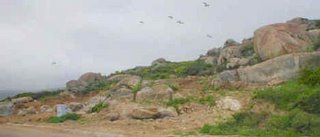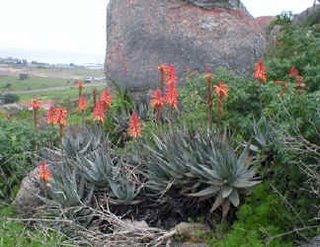more aloe buds Our winter is an exciting time with at least 80% of our aloes blooming from late fall to early spring. The real thrill is when a rare aloe blooms for the first time and buds are visible on our Aloe sabaea from Yemen! I have not seen this aloe in bloom except on a picture. Buds are also showing on Aloe rubroviolacea, also from Yemen and I have not seen it "live in bloom" either.
The raceme is often mentioned in describing aloes, it is the part of the stem on which the flowers are attached. The length of the raceme change the image of the flowering aloe a lot.
Directly below is Aloe mitriformis with a very short raceme.
Variations occur in this aloe - below is a longer raceme.
The buds of Aloe mitriformis on the left has just passed their green phase. This is the stage in the development of the flowers that I find the most attractive of this aloe, before it changes to the flowering shape on the photo right. Aloes tend to vary in the same species. The raceme is longer which space the flowers wider apart. The new bud can be seen on the right bottom of the photo on the left. It is obvious that the flowers will not be densely packed. However, that is not the only difference, these flowers are wider apart but much longer than the Aloe mitriformis flowers above - and how do you like those open flowers! The curling of the pedals are so charming. The bees do not have a problem pollinating these narrow long flowers as the nectar flow down and the pollen is also right at the opening of the flowers. The stigma will appear after the pollen is gone, most aloes are not self-fertile.
This is a lovely hybrid of Aloe petricola X Aloe speciosa. Aloe speciosa is obvious in the flowers and buds and Aloe petricola is prominent in the size and shape of the plant. A. petricola is not quite 50 cm high and Aloe speciosa is a tree aloe reaching 3 meter easy. This hybrid plant is just under 50 cm.
The many flower buds of Aloe speciosa are packed so tight that the raceme with buds feels as hard as a rock. Compare the buds of this aloe with the hybrid above - The buds are much alike but Aloe speciosa buds are very dense. The raceme with flowers on the photo above is 40 cm long.
---------------
What is the meaning of the word "cola" - The lovers of the drink need not answer.....
It means "inhabiting or dweller ". petri (from petros) = rock + cola would be ... rocks/stones .. inhabiting stones.
There is also an Aloe arenicola which grows on the west coast and it is a sand dweller.
Siamese queens
9 years ago








